Moving Figures
As ayahs and amahs travelled between colonies and metropoles, inhabiting the memories of employers and their children, they often appeared in paintings, postcards, photographs, and films. They were also shown caring for European children through statuettes and dolls that have been acquired by museums and collectors across the globe.
postcards
Postcards, emerging as an inexpensive medium of communication throughout the British empire in the 1870s, popularised the representations of ayahs and amahs. As images of the exotic Other, they illustrate considerable cultural and religious diversity. The pictures, typically drawn or photographed by local Asian and European artists, were produced on cards printed in Britain, Germany, and elsewhere, leading to their wide global circulation by the turn of the century.
Click on the images below to find out more information.

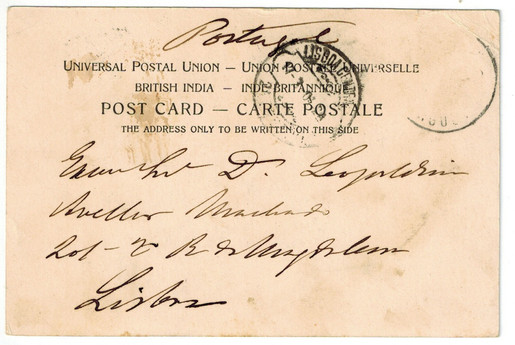

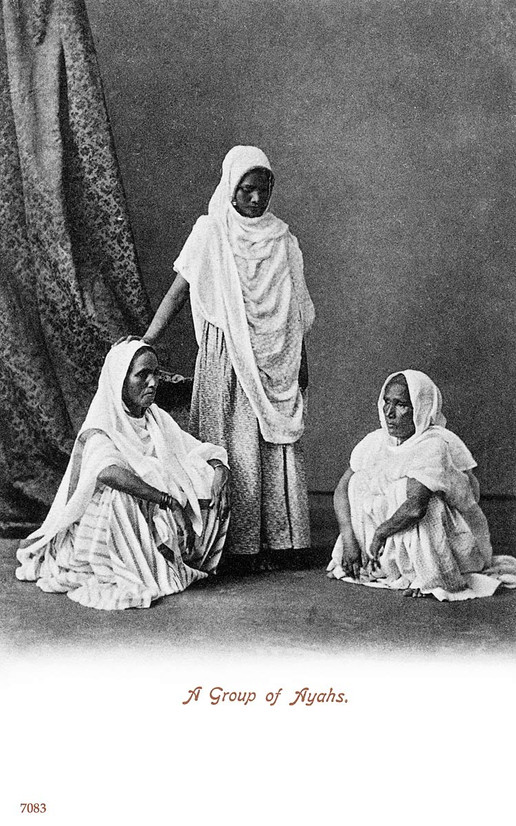
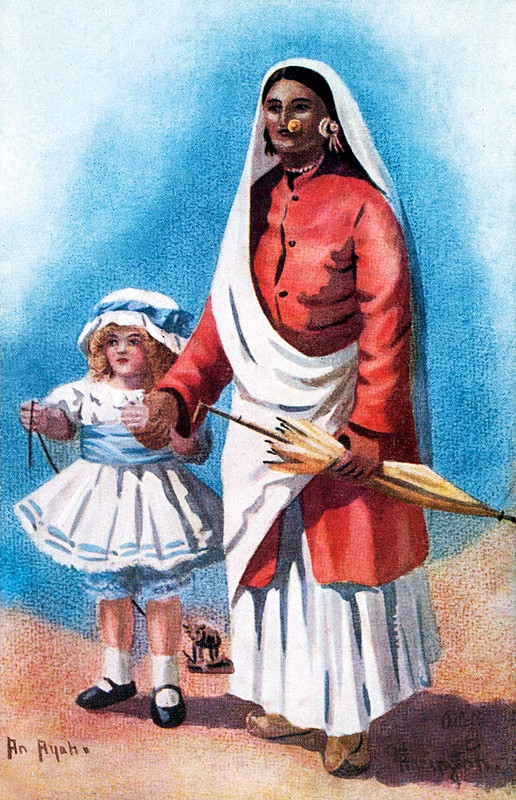
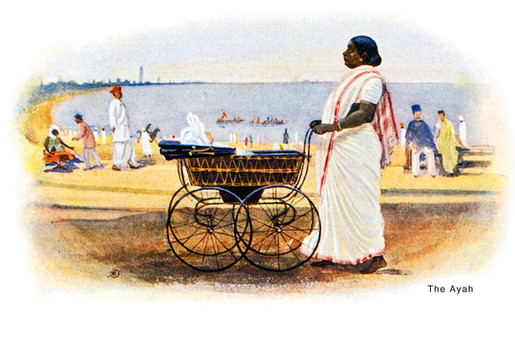
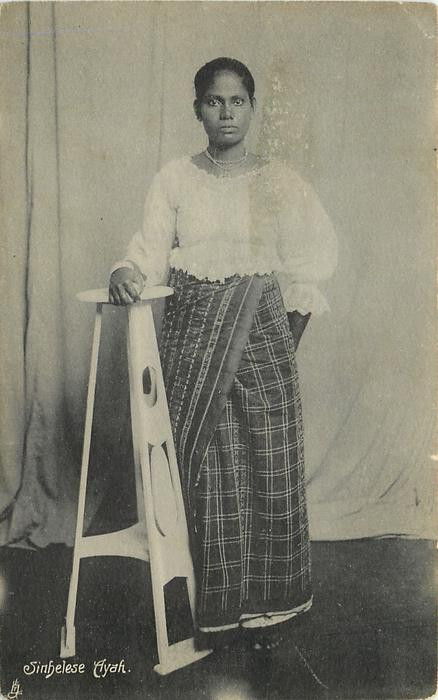

Dolls and Figurines
Ayahs were so indispensable to Anglo-Indian life that they became subjects of sculptures and playful artefacts. Artists from different parts of India made clay figurines of ayahs that mark their ubiquity in colonial life. The dolls and statues were modelled after real-life ayahs, dressed in the common colour scheme of white and red. Figurines of the amahs were much less common and are harder to find today, especially from the colonial period, but some collector dolls from the twentieth century survive.
Click on the markers below to view the dolls and figurines.


This description from an Australian newspaper of Chandi, an Indian ayah-doll, dwells primarily on her dress and accessories. We have seen how artists, in their varying rendition of ayahs, display a fascination with Indian attire. The article’s focus on the manner, clothing, and ornaments of the ayah was a way of exoticising native women. It conveys a sense of racial and cultural superiority that was prevalent across the former British colonies in the 1930s.
Click on the article to zoom in.
Dolls of all the nations
‘Dolls of All the Nations,’ Age (Melbourne, Victoria) September 6, 1935, p. 4 | Trove
Fine Art
Fascinating images of ayahs can be found in works of fine art. The ayahs as subjects of high art are painted in all their complexities. Their representations demonstrate the artists’ nostalgic sentimentalisation while also displaying the intimacy and the carework the ayahs rendered to their colonial rulers. Sometimes these artworks also directly reference the travels of the ayahs.

Emma Fullerton | 1879
This intimate portrait of an ayah with sleeping children represents the sentimentalisation of native caregivers’ affection for Anglo-Indian children. Painted by the Indian-born Philadelphian artist Emma W Fullerton (1857-1885), the rifle against the wall may reference the 1857 Indian Uprising while the accuracy of the details of the gold and silver-threaded red and white sari suggest that it could have been taken from real life. The painting establishes the power held by the ayah as an intimate Other, fulfilling key caring responsibilities in an Anglo-Indian household.
Indian Ayah with Sleeping Children, Painting, Oil on canvas, Emma W Fullerton, 1879 | Private Collection.
Indian Ayah with Sleeping Children


Going North
George Earl | c.1893
The presence of an ayah in this painting by George Earl (1824-1908) makes it clear that colonial careworkers were an integral part of British social fabric in the late nineteenth-century. King’s Cross station in London was a major public transport hub, taking ayahs who arrived from India north to employers’ homes in Scotland. The painting hung in a Liverpool pub before being acquired by the UK’s National Railway Museum in the 1990s.
Going North, Painting, Oil on canvas, George Earl, c. 1893 | Courtesy of Science Museum Group.



Joanna De Silva
This majestic portrait of Joanna de Silva drawn by the British artist William Wood (1769-1810) and currently on display in the Metropolitan Museum of Art, New York, is distinct from most other portraits of ayahs. Joanna de Silva was a native of Bengal, of Portuguese descent, and the ‘faithful and affectionate nurse’ of the children of the British Lieutenant Colonel Charles Deare posted in Calcutta. Following her employers’ death in Calcutta, she accompanied the Deare children to England where her portrait was made.
Joanna De Silva, Painting, Oil on canvas, William Wood, 1792 | Courtesy of The Met Museum.
William Wood | 1792
Nussiban, our ayah
Gertrude Ellen Burrard | 1895
The beautiful oil-portrait of the ayah Nussiban is the work of an amateur artist Gertrude Ellen Burrard (1860-1928). Burrard’s portraits memorialise members of the Indian community who served the artist during her years in India as an Army Officer’s wife. The painting preserves Nussiban’s name, something often lost in other paintings. In this intimate portrait, Nussiban is clothed in a beautifully tailored red blouse and white sari, the common colour-scheme for representing ayahs.
Nussiban, our ayah (nanny), Painting, Oil on canvas, Gertrude Ellen Burrard, 1895 | Courtesy of the National Army Museum, London.

Robert Taylor Pritchett | c. 1887
The famous British artist and illustrator, and former East India company gunmaker, later yachtsman, Robert Taylor Pritchett (1828-1907), travelled extensively. Here he renders a watercolour painting of ayahs with their charges in the white neighbourhood of Calcutta, the imperial capital. With magisterial buildings of the British officials in the background, the ayahs sit with children in the grasslands (maidan) that surround Fort William. The painting establishes the ubiquity and central roles of ayahs in the Anglo-Indian cityscape.
Ayahs with their Charges, Painting, Watercolour, Robert Taylor Pritchett, c. 1887 | The South Asia Collection Museum.
Ayahs with their Charges

Helen Allingham | 1877
On Dover Beach, by the Victorian woman artist Helen Allingham (1848-1946), seems to be a nostalgic portrayal of the world of working women but simultaneously displays the British empire’s dependence on the carework of women of color. A later painting by the Bombay-based artist M.V. Dhurandhar of an ayah pushing a stroller in the Malabar Beach resonates with this earlier drawing as does the Lindsay painting of Plum and Poona on Portsea Beach.
On Dover Beach, Painting, Watercolour, Helen Allingham, 1877 | Medici / Mary Evans
On Dover Beach
